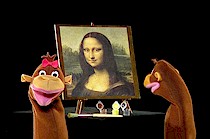|
|

This
edition in the Baby Einstein baby video series
focuses on parts of the body. Toddlers are introduced to
eyes, ears, and more, as they appear in nature. A unique
bilingual approach is offered in Baby Da Vinci: From Head
to Toe. As is typical of the series, this video/DVD
features little narration, but some key words are voiced in
English, Spanish, and French.
The format
is familiar—combinations of music, images of toys and
children, and puppet sequences form the bulk of the video.
In the presentation of the "nose", for example,
children watch live-action children pointing to their (and
each other's) noses, an elephant's trunk, a clown's big red
nose, and noses on statues. Toys entertain kids, and the
musical backdrop is the Baby Einstein series'
trademark classical music "re-orchestrated" on
musical toys.
For
the most part, the imagery is mesmerizing. The Baby
Einstein series features a familiar format, although
some videos are invariably going to appeal more to little
viewers than others. Some followers of the series prefer the
original videos, before Disney came along and backed the
whole project. In some ways, the original titles seem a
little more sincere. The production quality has improved,
although little ones are not as discriminating as adults in
this respect, and don't seem to mind either way. We find
both "stages" of the series engaging in different
ways. Some specific videos in the series are more engaging
to individual children, simply because they are more attuned
to the featured content. As such, parents will need to
experiment a little in order to determine which ones capture
their child's interest. Renting a few of the titles may be a
good idea before committing to buy.
We have our
own preferences, and both Baby Van Gogh
and Baby Shakespeare
(see our Favorite
Videos for Babies and Toddlers article) are our
personal favorites. We found a virtually unanimous positive
response to these videos by our young testers. We find that
there were more funny surprises (such as peek-a-boos and
silly antics) in the earlier editions in the series (with
the exception of the very first title, now called Language
Nursery). However, every child is different and responds
uniquely to the various titles in the series.
Besides the
tried-and-true format, Baby Da Vinci's strengths lie
in the appeal of discovering body parts in a variety of
ways. Floppy elephant ears are included in the
"ears" segment, a toy that resembles a standalone
nose waddles across the screen, a spunky "Head,
Shoulder, Knees and Toes" musical video segment spices
things up, bilingual language (although very sparse) boosts
the value of the video, and children get to see body parts
gradually appear as they watch an artist draw them. This
latter feature is completely boring to some toddlers, and
mesmerizing to others. When kids pay attention to the
drawing sequences, they have wonderful educational value, as
the gradual unfolding of each body part makes for a powerful
impression on young brains.
|